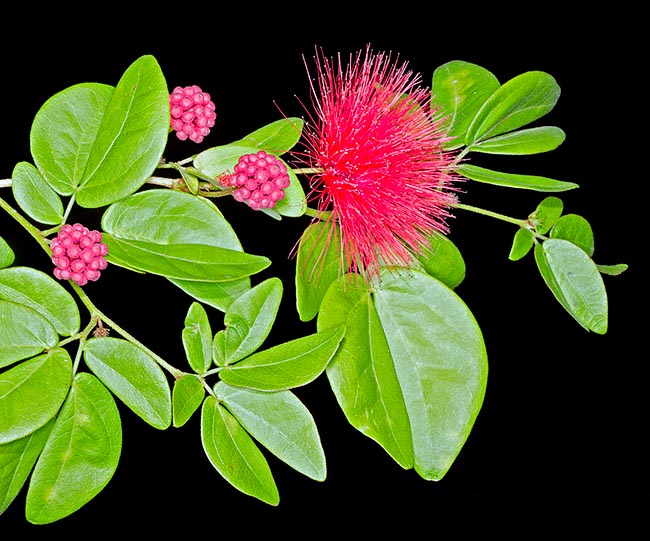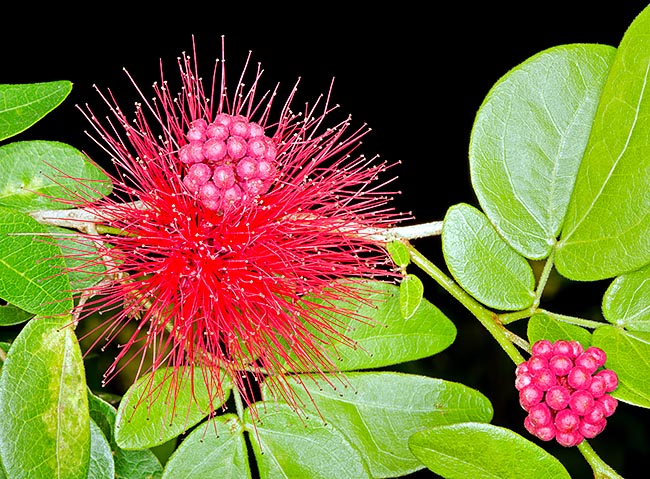Family : Fabaceae

Text © Pietro Puccio

English translation by Mario Beltramini

Calliandra tergemina var. emarginata is a 1-3 m shrub in bud in the tropics almost all the year © Giuseppe Mazza
The variety is native to Belize, Colombia, Costa Rica, El Salvador, Guatemala, Honduras, Mexico, Panama and Venezuela, where it grows in the forests on the banks of the rivers, in the valleys and on the slopes of the mountains up to about 1000 m of altitude.
The name of the genus is the combination of the Greek terms “kàllos” = beauty and “anér, andrós” = man, male, with reference to the conspicuous stamina; the name of the species is the Latin adjective “tergeminus, a, um” = triple, with reference to the three pairs of leaflets with which the leaf is composed; the name of the variety is the past participle of the Latin verb “emarginare” = to take off the margins, utilized in botany to indicate an organ with emarginated apex.
Common names: dwarf powderpuff plant, powderpuff plant (English); barba de cabro, guamuchilillo, pata de venado, tabardillo (Spanish).
The Calliandra tergemina var. emarginata (Willd.) Barneby (1998) is an evergreen unarmed shrub 1-3 m tall with rather thin cylindrical stems. The leaves, on a 0,5-3 cm long petiole, are alternated, bipinnate, with one pair of obovate-oblique leaflets, asymmetric in respect to the median nervation, with rounded, obtuse or slightly emarginate apex, 2,5-6 cm long, and a leaflet at the base, just over the bifurcation, 1-2,5 cm long; the leaves are initially orange, then glossy intense green.
Capitulum axillary inflorescences, of about 5 cm of diameter, on a 1,5-3 cm long peduncle, formed by a crowd of sessile hermaphrodite flowers arranged in strict contact one each other, with tubular corolla about 0,7 cm long and more or less intense red stamina, 2,5-3 cm long. The fruits are flat legumes abruptly pointed at the apex (apiculate), 5-10 cm long and about 0,7 cm broad, of brown colour, containing 6-8 flat seeds of dark brown colour, oval to elliptic, about 0,6 cm long and 0,3 cm broad, which suddenly open when ripe throwing the seeds at a distance of various metres. It reproduces by seed, previously kept for one day in water, on sandy and rich of humus loam at the temperature of 20-24 °C, with germination times of 1-3 weeks and first flowering starting from the second year of age, and by semi-woody cutting in summer. Species of great ornamental effect due to the foliage and the copious and showy flowering which at the tropics continues for almost all the year.

Showy capitulum axillar inflorescences of 5 cm of diameter © Giuseppe Mazza
It can be successfully cultivated also in pot, for the decoration of courtyards, patios and terraces, besides for luminous interiors, where the climate doesn’t allow the permanent cultivation in open air, with frequent and abundant watering in summer, spaced, but without letting the substratum to dry up completely, in winter, minimum temperatures not under +15 °C, and fertilizations preferably slow releasing in spring. Due to its characteristics, it is often used as bonsai.
Synonyms: Inga emarginata Willd. (1806); Mimosa emarginata Poir. (1810); Inga canescens Cham. & Schltdl. (1830); Mimosa tetraphylla Sesse & Moc. (1831); Inga tetraphylla G.Don (1832); Inga semicordata Bertol. (1840); Calliandra canescens Benth. (1844); Calliandra emarginata (Willd.) Benth. (1844); Calliandra seemannii Seem. (1853); Calliandra tetraphylla (G.Don) Benth. (1875); Feuilleea canescens Kuntze (1891); Feuilleea emarginata Kuntze (1891); Feuilleea seemannii (Seem.) Kuntze (1891); Feuilleea tetraphylla Kuntze (1891); Calliandra rupestris Brandegee (1905); Calliandra purpusii Brandegee (1915); Calliandra langlassei Harms (1921); Calliandra mexicana Brandegee (1922); Anneslia canescens Britton & Rose (1928); Anneslia cruziana Britton & Rose (1928); Anneslia deamii Britton & Rose (1928); Anneslia emarginata (Willd.) Britton & Rose (1928); Anneslia juchitana Britton & Rose (1928); Anneslia langlassei Britton & Rose (1928); Anneslia mexicana Britton & Rose (1928); Anneslia rupestris Britton & Rose (1928); Anneslia seemannii (Seem.) Britton & Rose (1928); Anneslia sinaloana Britton & Rose (1928); Anneslia yucatanensis Britton & Rose (1928); Calliandra cruziana Standl. (1929); Calliandra deamii (Britton & Rose) Standl. (1929); Calliandra yucatanensis (Britton & Rose) Standl. (1929); Calliandra sinaloana Standl. (1933); Calliandra tolimensis Uribe (1942); Calliandra uribei Killip & Dugand (1944).
→ To appreciate the biodiversity within the family of FABACEAE please click here.
